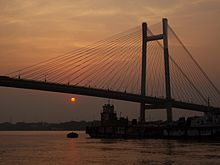Vidyasagar Setu
| Vidyasagar Setu বিদ্যাসাগর সেতু |
|
|---|---|

Vidyasagar Setu at Sunset
|
|
| Coordinates | 22°33′25″N 88°19′40″E / 22.55694°N 88.32778°ECoordinates: 22°33′25″N 88°19′40″E / 22.55694°N 88.32778°E |
| Carries | Two-way with 3 general-purpose lanes in each direction |
| Crosses | Hooghly River |
| Locale | Kolkata, West Bengal |
| Official name | Vidyasagar Setu |
| Other name(s) | Second Hooghly Bridge দ্বিতীয় হুগলী সেতু |
| Maintained by | Hooghly River Bridge Commissioners |
| Characteristics | |
| Design | Cable-stayed bridge |
| Total length | 822.96 metres (2,700 ft) |
| Width | 35 metres (115 ft) |
| Longest span | 457.2 metres (1,500 ft) |
| Clearance below | 26 metres (85 ft) |
| History | |
| Constructed by | The Braithwaite Burn and Jessop Construction Company Limited |
| Opened | 10 October 1992 |
| Statistics | |
| Daily traffic | 45,000 - 61,000 vehicles (February 2008) |
| Toll | Yes, toll bridge |
Vidyasagar Setu (Bidyasagôr Setu), also known as the Second Hooghly Bridge (Dbitiyô Hugli Setu), is a toll bridge over the Hooghly River in West Bengal, India, linking the cities of Kolkata (previously known as Calcutta) and Howrah.
With a total length of 823 metres (2,700 ft), Vidyasagar Setu is the longest cable–stayed bridge in India. It was the second bridge to be built across the Hooghly River; the first, the Howrah Bridge (also known as Rabindra Setu) 3.7 kilometres (2.3 mi) to the north, was completed in 1943. Named after the educationist reformer Pandit Ishwar Chandra Vidyasagar, it cost ₹3.88 billion to build. The project was a joint effort between the public and private sectors, under the control of the Hooghly River Bridge Commissioners (HRBC).
Initially, under the toll collection regime of the HRBC, daily traffic was recorded to be a minimum of 28,000 vehicles and a maximum of 39,000 vehicles in 2000, but fell to a maximum of around 30,000 vehicles by December 2002, when the management of the toll plaza was handed over to a private firm. Subsequently, the daily traffic reached a minimum of 45,000 vehicles and a maximum of 61,000 vehicles by early 2008, against a maximum capacity of 85,000 vehicles per day. The original management of the toll revenue collection by HRBC was consequently criticized for corruption and significant loss of revenue.
Population and commercial activity grew rapidly after India gained independence in August 1947. The only link across the Hooghly River, the Howrah Bridge, between Howrah and Kolkata, was subject to much traffic congestion, with over 85,000 vehicles every day. This necessitated planning for a new bridge across the river so that it could connect to the major cities of Mumbai (Bombay), Delhi and Chennai (Madras) through the national highways located close to the bridge.
The foundation stone for the bridge was laid by Indira Gandhi on 20 May 1972. The bridge took more than 22 years to complete and cost Indian Rupees 3.88 billion, but in seven of those years there was no construction activity. The bridge is named after the 19th-century Bengali educationist reformer Pandit Ishwar Chandra Vidyasagar. Work on the cable-stayed bridge started with the construction of the well curb on the Calcutta bank end on 3 July 1979.
...
Wikipedia

